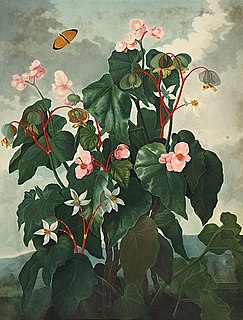
Begonia is a genus of perennial flowering plants in the family Begoniaceae. The genus contains more than 2,000 different plant species. The Begonias are native to moist subtropical and tropical climates. Some species are commonly grown indoors as ornamental houseplants in cooler climates. In cooler climates some species are cultivated outside in summertime for their bright colorful flowers, which have sepals but no petals.

Palawan, officially the Province of Palawan, is an archipelagic province of the Philippines that is located in the region of Mimaropa. It is the largest province in the country in terms of total area of jurisdiction. Its capital is the city of Puerto Princesa, but the city is governed independently from the province as a highly urbanized city.
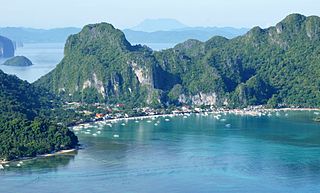
El Nido, officially the Municipality of El Nido, is a 1st class municipality in the province of Palawan, Philippines. According to the 2020 census, it has a population of 50,494 people.
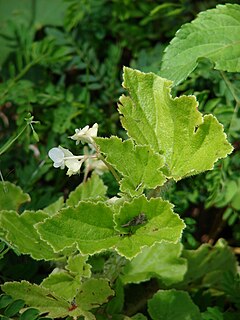
Begoniaceae is a family of flowering plants with two genera and about 1825 species occurring in the subtropics and tropics of both the New World and Old World. All but one of the species are in the genus Begonia. There have been many recent discoveries of species in the genus Begonia, such as Begonia truncatifolia which is endemic to San Vincente, Palawan. B. truncatifolia is smaller in size than other species of the genus Begonia and this new species is proposed Critically Endangered by standards set by the IUCN. The only other genus in the family, Hillebrandia, is endemic to the Hawaiian Islands and has a single species. Phylogenetic work supports Hillebrandia as the sister taxon to the rest of the family. The genus Symbegonia was reduced to a section of Begonia in 2003, as molecular phylogenies had shown it to be derived from within that genus. Members of the genus Begonia are well-known and popular houseplants.

Alastair S. Robinson is a taxonomist and field botanist specialising in the carnivorous plant genus Nepenthes, for which he is regarded as a world authority. He is currently a manager at the National Herbarium of Victoria, Royal Botanic Gardens Melbourne, where he oversees identification botany services, the Library and Artwork components of the State Botanical Collection, and the botanical journal Muelleria, a peer-reviewed scientific journal on botany published by the Royal Botanic Gardens Victoria, for which he is Editor in Chief.
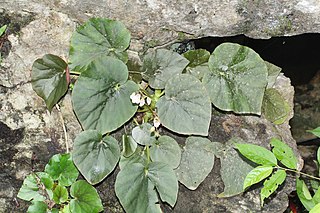
Begonia elnidoensis is an endemic species of Begonia discovered in El Nido, Palawan, Philippines. The species was compared to Begonia wadei, in that both species have thick-trunked stem, differing in the widely to very widely ovate or subtriangular leaves, with the latter having obliquely ovate leaves, 3-4 secondary leaf veins where the latter has 6 on each side of the midrib, with glabrous petioles compared to latter having puberulous to tomentose, an inflorescence measuring 20–40 cm in length compared to only 6–20 cm, and the differently-sized bracts and capsules.
Begonia balangcodiae is an endemic species of Begonia discovered in Sagubo, Kapangan, Benguet, Philippines. The species was allied to B. esculenta Merr., from which it is distinguished by its cordate leaf base and white tepals, while the latter's leaf base is not cordate and has a vermilion-colored tepals. On the same hand, this species resembles that of B. leucosticta Warburg, differing from the latter on cordate leaf base versus subcordate leaf base, and larger tepals ranging in size from 12–18 mm long in pistillate flowers versus the latter's 3–5 mm. Additionally, this species is similar to B. negrosensis Elmer, in that it has lanceolate, glabrous leaf compared to that of latter's obovately oblong and sparsely hairy leaves, and white to greenish tepals, versus that of latter's pinkish tepals.
Begonia gironellae is an endemic species of Begonia discovered in Tanabag, Puerto Princesa, in northern Palawan, Philippines. The species resembled Begonia cleopatrae, in that both species have widely ovate, variegated leaves, and fleshy hairs fused into a ring at the base of the leaf petiole. However, Begonia gironellae differed from B. cleopatrae due to its rosette habit with rhizome shorter to 5 cm long, with very congested internodes, widely triangular stipules, differently-sized lamina and bracts, and capsule with wider abaxial wing. Additionally, B. gironellae is a lowland species occurring in broadleaved seaside forests, while B. cleopatrae grows on hill forest at ca. 400m.
Begonia quinquealata is an endemic species of Begonia discovered in Salakot Falls, Napsan, Puerto Princesa City, in northern Palawan, Philippines. This species, along with B. suborbiculata Merr., are the only two known species in the Philippines with 5-winged capsules. Unlike any other member of Begonia sect. Baryandra, B. quinquealata is very distinctive for being a densely hairy herb with long creeping rhizomes. It differs also from B. suborbiculata in that it has thickly chartaceous, widely ovate leaves that have uniformly green upper leaf surface, densely velutinous, with denticulate leaf margin, outer tepals, and red scabrous ovary and capsules.
Begonia tabonensis is an endemic species of Begonia discovered in Tabon Cave, Lipuun Point, Municipality of Quezo, in Palawan, Philippines. This species resembles B. mindorensis Merr., widely ovate and uniformly green leaves, and inflorescence with sessile glands. However the two species differs on several characteristics: Begonia tabonensis have shorter petioles(10 cm long), smaller leaves(4-8 x 4–6.4 cm); deciduous, chartaceous, glabrous or very sparsely glandular bracts; and slightly pointed, crescent-shaped ovary wing; whereas, B. mindorensis have longer petioles(25 cm long), larger leaves(10-15 x 6-10 cm); persistent, coriaceous, densely glandular bracts; and acute, triangular ovary wing.
Begonia tenuibracteata is an endemic species of Begonia discovered in Salakot Falls, Napsan, Puerto Princesa City, in northern Palawan, Philippines occurring on mossy boulders along road cut in shaded, wet lowland forest. This species, along with B. mindorensis, produces the unusual, conspicuous, persistent bracts on the inflorescences. However, it sharply distinct from the latter due to its ovate to lanceolate bracts, which are hyaline, membranaceous, glabrous or with very sparse sessile glands where the latter have widely to depressed ovate bracts that are coriaceous, densely clothed with sessile glands. Additionally, B. tenuibracteata differs by the congested rhizomes with internodes only to 3 mm long; with shorter petioles ; velvety upper leaf surface; shorter inflorescence ; and fewer stamens (40–50); whereas B. mindorensis have 20 mm long rhizome internodes, petioles 10–25 cm long, glossy upper leaf surface, inflorescence over 35 cm long, and up to ca. 70 stamens
Begonia adamsensis is an endemic species of Begonia discovered in Adams, Ilocos Norte province, Luzon, Philippines occurring at an altitude of 308 m above sea level. The species broad-based leaves that are peltate, with a glabrous peduncle, an acuminate tip and nearly entire margin, resembled that of Begonia hernandioides. However, there are differences, in that B. hernandioides had red-colored stipule that is broadly ovate, the petiole and abaxial lamina is pubescent, and the peltate leaves are elliptic.
Begonia beijnenii is a species of flowering plant in the family Begoniaceae, native to the island of Palawan in the Philippines.
Dendrochilum ignisiflorum is a species of orchid endemic in Benguet province in the Philippines.

Begonia caramoanensis is a species of flowering plant in the family Begoniaceae, native to the island of Luzon in the Philippines.
Corybas circinatus is a species of flowering plant from the family Orchidaceae endemic to ultramafic habitats on the island of Palawan, Philippines, The endemic helmet orchid was first photographed at Mount Victoria in June 2007. This species is distinct in bearing a small glandular protuberance at the front of its pedicel, a 4-lobed entire labellum, and a distinctive strongly incurved dorsal sepal. The general colouration of the floral and vegetative parts is also highly characteristic, and the general lowland to mid-montane ecology of the species is unique amongst the known Philippines Corybas. The research was initiated by the Philippine Taxonomic Initiative, Inc.
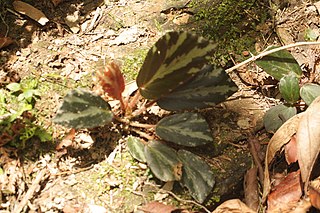
Begonia truncatifolia is a species of flowering plant in the family Begoniaceae, native to the island of Palawan in the Philippines.
The Philippine Taxonomic Initiative (PTI) is a private Philippine research institute and non-profit organization located in Palawan.
Danilo Tandang is a Filipino botanist, working in the National Museum of the Philippines, Philippines







